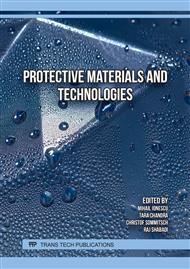p.3
p.9
p.15
p.21
p.29
p.35
p.41
p.49
Optimization of Anodizing Condition for Mg-14mass%Li-3mass%Al Alloy
Abstract:
Mg-Li system alloys also has excellent cold-workability compared to commercial hcp-structured Mg alloys. However, Mg-Li alloys have poor corrosion resistance because not only that is Mg-based alloy but Li as a major alloying element is a less noble metal. For example, Mg-Li alloy sheet indicates high corrosion rate and exfoliation corrosion as a result of long-term corrosion test. The authors reported Mg-14 mass%Li-3 mass%Al alloy has the highest corrosion resistance in β-type solid solution alloy. Even though the optimized alloy composition, the alloy does not have enough corrosion resistance for practical use. In this study, anodized coating on Mg-Li alloy using phosphate solution was investigated. Anodizing of Mg-Li alloy facilitates the dissolution of substrate because of high Li concentration in this alloy. Therefore, the anodizing conditions were widely examined. As a result, the coating with approximately 15-20 μm of the surface layer was successfully formed. The surface layer was composed of MgAl2O4 and some phosphorus compounds. The thickness of anodized layer varied with the anodizing conditions. The dense surface layer was formed at a certain anodizing voltage and the corrosion resistance of anodized Mg-Li alloys was improved. However, the surface has some cracks and large flaky compounds. The formation mechanism of dense layer during anodizing were discussed.
Info:
Periodical:
Pages:
9-13
Citation:
Online since:
December 2023
Authors:
Keywords:
Price:
Сopyright:
© 2023 Trans Tech Publications Ltd. All Rights Reserved
Share:
Citation:



